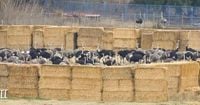On a cold November night in Edgewood, British Columbia, the usually quiet Universal Ostrich Farms became the center of a controversy that has since rippled across Canada. Hundreds of ostriches, known for their intelligence and tight social bonds, were corralled into a makeshift pen of hay bales and shot en masse by professional marksmen. The cull, carried out under the direction of the Canadian Food Inspection Agency (CFIA), has been met with outrage and sorrow, prompting animal rights advocates to file formal complaints and demand accountability.
According to Animal Justice, a leading animal law organization, the grim events unfolded just hours after the Supreme Court of Canada dismissed the farm’s final appeal in a protracted legal battle over an avian flu outbreak first detected nearly a year prior. While the birds had reportedly recovered from the virus, the order to kill them was executed swiftly and without further testing, despite calls from Animal Justice and independent disease experts to reassess the necessity of such drastic action.
Eyewitnesses described a harrowing scene: ostriches, startled and confused, were driven into the pen as darkness fell. The sound of gunfire echoed through the night, and the chaos and fear among the flock were palpable. Katie Pasitney, whose mother co-owns Universal Ostrich Farms, recounted the ordeal to The Canadian Press, calling the hours-long gunfire "overwhelming" and the method of killing "inhumane." She wasn’t alone in her condemnation. Camille Labchuk of Animal Justice Canada echoed the sentiment, stating that the ostriches in B.C. were culled in “the least appropriate method possible.”
The CFIA, for its part, defended its actions. In a statement published on November 13, 2025, the agency said it had determined, after consulting with experts experienced in managing ostrich disease outbreaks, that the use of professional marksmen was "the most appropriate and humane option" available. The agency also noted that all personnel who entered designated "hot" zones wore personal protective equipment or were thoroughly disinfected upon exit, and that all equipment was sanitized as well.
But Animal Justice and other critics argue that the CFIA ignored its own guidelines, which specifically warn against using firearms to kill ostriches due to their small skulls and the risk of severe injury. Ostriches, the group points out, are not only fast-moving but also form close-knit social groups, making the act of killing them in front of each other extremely distressing. Animal Justice contends that these actions may have violated both federal and provincial animal cruelty laws, which prohibit causing unnecessary suffering and distress to animals. They have formally requested that the CFIA investigate those involved in directing and carrying out the cull.
The aftermath of the cull was as grim as the event itself. The CFIA reported that the carcasses of all 314 ostriches, along with eggs and other materials, were disposed of through "deep burial" at a local landfill. The farm remains under quarantine, with strict biocontainment measures in place. Before the site can resume operations, it must undergo a rigorous cleaning and disinfection process approved by the CFIA, possibly followed by a "fallow period" under agency oversight. Any compensation claims by the farm owners will be reviewed according to the Health of Animals Act and related regulations, which are designed to encourage early reporting of animal disease and cooperation with eradication efforts.
The cull at Universal Ostrich Farms is not an isolated incident. Since 2021, more than 11 million birds—including chickens, ducks, turkeys, and now ostriches—have been killed on Canadian farms in response to avian flu outbreaks. The methods used in these mass culls have come under increasing scrutiny. Documents obtained by Animal Justice reveal that the CFIA’s operations in 2022 and 2023 were marked by what the group calls “brutality and incompetence,” with birds killed using carbon dioxide gassing, neck-breaking, and shooting. In one particularly disturbing case, the agency experimented with nitrogen foam suffocation, leaving many birds alive and conscious before they were manually killed.
Further fueling public concern is the revelation that the CFIA hired companies with prior animal cruelty convictions—such as Elite Farm Services and Hendrix Genetics—to carry out culls, paying them hundreds of thousands of taxpayer dollars. Meanwhile, farms that failed to maintain proper biosecurity and contributed to the spread of disease received millions in government bailouts. Between January 2022 and April 2023 alone, more than $107 million in public funds went toward disposal and compensation costs for over 100 farms affected by avian flu.
Animal Justice argues that these practices expose deep flaws in Canada’s approach to managing animal disease outbreaks. The group maintains that the crowded, unsanitary conditions typical of factory farms create the perfect environment for diseases like avian flu to spread rapidly, necessitating brutal culls to protect the broader industry. "True prevention begins with reforming the factory farming system that fuels these outbreaks," Animal Justice stated in its complaint. The organization is calling for a shift toward more humane, sustainable farming models that prioritize both animal welfare and public health.
As the dust settles at Universal Ostrich Farms, the broader debate about how Canada handles animal disease outbreaks and the treatment of farmed animals continues to intensify. The stark images of ostriches penned in and shot, the outcry from animal advocates, and the mounting costs to taxpayers have all contributed to a growing sense that the current system is failing to protect animals, farmers, or the public. Whether the CFIA’s actions will be investigated—or whether this incident will spark meaningful change in Canadian farming practices—remains to be seen. But for the 314 ostriches lost that night, and for those still at risk in similar situations, the questions raised by this tragedy are unlikely to fade any time soon.





